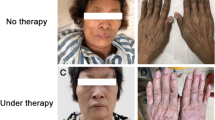Abstract
Veno-occlusive disease was diagnosed in an 18-month-old boy who had regularly consumed a herbal tea mixture since the 3rd month of life. The boy developed portal hypertension with severe ascites. Histology of the liver showed centrilobular sinusoidal congestion with perivenular bleeding and parenchymal necrosis without cirrhosis. The tea contained peppermint and what the mother thought was coltsfoot (Tussilago farfara). The parents believed the tea aided the healthy development of their child. Pharmacological analysis of the tea compounds revealed high amounts of pyrrolizidine alkaloids. Seneciphylline and the corresponding N-oxide were identified as the major components by thin-layer chromatography, mass spectrometry and NMR spectroscopy. We calculated that the child had consumed at least 60 μg/kg body weight per day of the toxic pyrrolizidine alkaloid mixture over 15 months. Macroscopic and microscopic analysis of the leaf material indicated thatAdenostyles alliariae (Alpendost) had been erroneously gathered by the parents in place of coltsfoot. The two plants can easily be confused especially after the flowering period. The child was given conservative treatment only and recovered completely within 2 months.
Similar content being viewed by others
Abbreviations
- VOD :
-
veno-occlusive disease
- FABMS :
-
fast atom bombardment mass spectrometry
- NMR :
-
nuclear magnetic resonance
References
Bras G, Jelliffe DB, Stuart KL (1954) Veno-occlusive disease of liver with nonportal type of cirrhosis, occurring in Jamaica. Arch Pathol 57:285–300
Huxtable RJ (1979) New aspects of the toxicology and pharmacology of pyrrolizidine alkaloids. Gen Pharmacol 10:159–167
Huxtable RJ (1990) Herbal teas and toxins: novel aspects of pyrrolizidine poisoning in the United States. Perspect Biol Med 24:1–14
Huxtable RJ (1990) The harmful potential of herbal and other plant products. Drug Safety 5 [Suppl 1]:126–136
Lüthy J, Zweifel U, Schlatter C, Benn MH (1980) Pyrrolizidin-Alkaloide in Huflattich (Tussilago farfara L.) verschiedener Herkunft. Mitt Geb Lebensm Hyg 71:73–80
Lüthy J, Zweifel U, Schmid P, Schlatter C (1983) Pyrrolizidin-Alkaloide in Petasites hybridus L. und P. albus L. Pharm Acta Helv 58:98–100
Mattocks AR (1967) Detection of pyrrolizidine alkaloids on thin layer chromatography. J Chromatogr 27: 505–508
McLean EK (1974) Senecio and other plants as liver poisons. Isr J Med Sci 10:436–440
Mohabbat O, Shafiq Younos M, Merzad AA, Srivastava RN, Gholam Ghaos Sediq, Aram G. N. (1967) An outbreak of hepatic veno-occlusive disease in North-Western Afghanistan. Lancet II:269–271
Mowat AP (ed) (1987) Liver disorders in childhood. Butterworths, London
Pui-Hay But P (1993) Need for correct identification of herbs in herbal poisoning. Lancet 341:637
Ridker PM (1987) Toxic effects of herbal teas. Arch Environ Health 42: 133–136
Ridker PM (1989) Hepatic veno-occlusive disease and herbal teas. J Pediatr 115:167
Ridker PM, McDermott WV (1989) Comfrey herb tea and hepatic veno-occlusive disease. Lancet I:657–658
Ridker PM Ohkuma S, McDermott WV, Trey C, Huxtable RJ (1985) Hepatic venocclusive disease associated with the consumption of pyrrolizidine containing dietary supplements. Gastroenterology 88:1050–1054
Röder E (1988) Wie gefährlich ist Huflattich als Hustentee? Dtsch Apoth Ztg 128, 43:2321–2322
Röder E, Plassmeier C (1991) Pyrrolizidin-Alkaloide der Gattung Adenostyles. Sci Pharm 59:301–306
Roulet M, Laurini R, Rivier L, Calame A (1988) Hepatic veno-occlusive disease in newborn infant of a woman drinking herbal tea. J Pediatr 112: 433–436
Rosenthal DA (1861), Heil-, Nutz- und Giftpflanzen aller Länder. Ferdinand Enke, Erlangen, p 263
Sommer M (1989) Hepatic veno-occlusive disease and drinking of herbal teas. J Pediatr 115:659–660
Spang R (1989) Toxicity of tea containing pyrrolizidine alkaloids. J Pediatr 115:1025
Westendorf J (1992) Pyrrolizidine Alkaloids-General Discussion. In: De Smet PAGM, Keller K, Hänsel R, Chandler RF (eds) Adverse effects of herbal drugs. Springer, Berlin Heidelberg New York, pp 193–205
Weston CFM, Cooper BT, Davies JD, Levine DF (1987) Veno-occlusive disease of the liver secondary to ingestion of comfrey. BMJ 295:183
Author information
Authors and Affiliations
Rights and permissions
About this article
Cite this article
Sperl, W., Stuppner, H., Gassner, I. et al. Reversible hepatic veno-occlusive disease in an infant after consumption of pyrrolizidine-containing herbal tea. Eur J Pediatr 154, 112–116 (1995). https://doi.org/10.1007/BF01991912
Received:
Accepted:
Issue Date:
DOI: https://doi.org/10.1007/BF01991912




